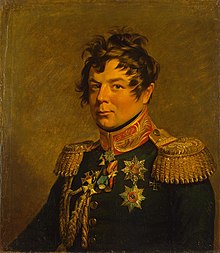Hans Karl von Diebitsch
Hans Karl von Diebitsch | |
|---|---|
 | |
| Born | 13 May 1785 Groß Leipe, Lower Silesia, Kingdom of Prussia |
| Died | 10 June 1831 (aged 46) Kleszewo, Kingdom of Poland |
| Allegiance | |
| Service/ | Army |
| Years of service | 1801–1831 |
| Rank | Field marshal |
| Battles/wars | War of the Third Coalition |
| Awards | Order of St. George Pour le Mérite Order of the Red Eagle Order of St. Vladimir Order of Saint Anna Order of Saint Alexander Nevsky Order of Leopold (Austria) Kulm Cross Gold Sword for Bravery Order of the White Eagle Military Order of Maria Theresa |
Hans Karl Friedrich Anton Graf[2] von Diebitsch und Narten (Russian: Ива́н Ива́нович Ди́бич-Забалка́нский, tr. Iván Ivánovič Díbič-Zabalkánskij; 13 May 1785 – 10 June 1831) was a German-born soldier serving as Russian field marshal.
Career[]
Hans Karl was educated at the Berlin cadet school, but by the desire of his father, Frederick II's aide-de-camp who had passed into the service of Russia, he also did the same in 1801. He served in the campaign of 1805, and was wounded at Austerlitz, fought at Eylau and Friedland, and after Friedland was promoted captain.[3]
During the next five years of peace he devoted himself to the study of military science, engaging once more in active service in the War of 1812. He distinguished himself very greatly in Wittgenstein's campaign, and in particular at Polotsk (18 and 19 October), after which combat he was raised to the rank of major-general. In the latter part of the campaign he served against the Prussian contingent of General Yorck (von Wartenburg), with whom, through Clausewitz, he negotiated the celebrated convention of Tauroggen, serving thereafter with Yorck in the early part of the German Campaign of 1813.[3]
After the battle of Lützen (1813) he served in Silesia and took part in negotiating the secret treaty of Reichenbach. Having distinguished himself at the battles of Dresden and Leipzig he was promoted lieutenant-general. At the crisis of the campaign of 1814 he strongly urged the march of the allies on Paris; and after their entry the emperor Alexander conferred on him the order of St Alexander Nevsky.[3]
In 1815 he attended the Congress of Vienna, and was afterwards made adjutant-general to the emperor, with whom, as also with his successor Nicholas, he had great influence. By Nicholas he was created baron, and later count. In 1820 he had become chief of the general staff, and in 1825 he assisted in suppressing the Decembrist revolt.[3]
His greatest exploits were in the Russo-Turkish War of 1828–1829, which, after a period of doubtful contest, was decided by Diebitsch's brilliant campaign of Adrianople; this won him the rank of field-marshal and the victory title of Zabalkanski to commemorate his crossing of the Balkans.[3]
In 1830 he was appointed to command the great army destined to suppress the November Uprising in Poland. After the inconclusive battle of Grochow on 25 February, he won the battle of Ostrołęka on 26 May, but soon afterwards died of cholera at Kleszewo near Pułtusk, on 10 June 1831.[3]
References[]
- ^ The State Hermitage. Western European painting. Catalog. 2nd Volume
- ^ Regarding personal names: Until 1919, Graf was a title, translated as Count, not a first or middle name. The female form is Gräfin. In Germany since 1919, it forms part of family names.
- ^ Jump up to: a b c d e f One or more of the preceding sentences incorporates text from a publication now in the public domain: Chisholm, Hugh, ed. (1911). "Diebitsch, Hans Karl Friedrich Anton". Encyclopædia Britannica. 8 (11th ed.). Cambridge University Press. p. 209. Endnotes:
- (in German) Belmont (Schumberg), Graf Diebitsch (Dresden, 1830);
- (in German) Strmer, Der Tod des Grafen Diebitsch (Berlin, 1832);
- (in Russian) Bantych Kamenski, Biographies of Russian Field-Marshals (St Petersburg, 1841)
Further reading[]
- Chesney, Russo-Turkish Campaigns of 1828–29, (New York, 1856).
- . Encyclopedia Americana. 1920.
- 1785 births
- 1831 deaths
- People from Oborniki Śląskie
- People from the Province of Silesia
- People of the Russian Empire of German descent
- Russian people of German descent
- Russian nobility
- Members of the State Council (Russian Empire)
- Field marshals of Russia
- Russian commanders of the Napoleonic Wars
- Russian people of the November Uprising
- Deaths from cholera
- Recipients of the Pour le Mérite (military class)
- Recipients of the Order of St. George of the First Degree
- Knights Cross of the Military Order of Maria Theresa